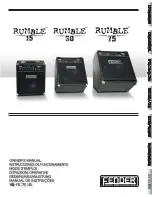
Page 23
Com-Tech Power Amplifiers
Reference Manual
7. If the size of the cable exceeds what you want to use,
(1) find a way to use shorter cables, like using the
IQ
System, (2) settle for a lower damping factor, or (3) use
more than one cable for each line. Options 1 and 2 will
require the substitution of new values for cable length
or damping factor in the nomograph. For option 3, esti-
mate the effective wire gauge by subtracting 3 from the
apparent wire gauge every time the number of con-
ductors of equal gauge is doubled. So, if #10 wire is
too large, two #13 wires can be substituted, or four #16
wires can be used for the same effect.
SOLVING OUTPUT PROBLEMS
High-frequency oscillations
can cause your amplifier
to prematurely activate its protection circuitry. The ef-
fects of this problem are similar to the RF problems de-
scribed in Section 3.3.2. To prevent high-frequency
oscillations:
1. Bundle together each pair of loudspeaker conduc-
tors when using long cable runs or when different
amplifiers use a common cable tray or jacket. (Do
NOT bundle wires from different amplifiers.) This
reduces the chance of conductors acting like an-
tennas to transmit or receive the high frequencies
that can cause oscillation.
2. Avoid using shielded loudspeaker cable.
3. Never tie together input and output grounds.
4. Never tie together the output of different amplifiers.
5. Keep output cables separated from input cables.
6. Install a low-pass filter in series with each input
(see Section 3.3.2).
7. Install the input wiring according to the instructions
in Section 3.3.2.
Another problem to avoid is the presence of large
infra-
sonic currents
when primarily inductive loads are
used. Examples of inductive loads are 70-volt trans-
formers and electrostatic loudspeakers.
Inductive loads can appear as a short circuit at low fre-
quencies. This can cause the amplifier to produce large
low-frequency currents and activate its protection cir-
cuitry. Always take the precaution of installing a high-
Fig. 3.15 Inductive Load (Transformer) Network
4 ohm, 20 watt
Resistor
590 to 708
µ
f Capacitor
120 VAC, N.P.
+
–
Inductive
Load
+
–
From
Amplifier
Output
pass filter in series with the amplifier’s input when induc-
tive loads are used. A three-pole, 18-dB-per-octave fil-
ter with a –3 dB frequency of 50 Hz is recommended
(some applications may benefit from an even higher –3
dB frequency). Such a filter is described with infrasonic
frequency problems in Section 3.3.2.
Another way to protect inductive loads from large low-
frequency currents and prevent the amplifier from pre-
maturely activating its protective systems is to parallel a
590 to 708 µF nonpolarized motor start capacitor and a
4-ohm, 20-watt resistor in series with the amplifier out-
put and the positive (+) transformer lead. This circuit is
shown in Figure 3.15. It uses components that are avail-
able from most electrical supply stores.
3.3.5 Additional Load Protection
Com-Tech amplifiers can generate enormous power
output. Using 8/4-ohm output, if your loudspeakers do
not have built-in protection from excessive power, it’s a
good idea to protect them. Loudspeakers are subject
to thermal damage from sustained overpowering and
mechanical damage from large transient voltages. In
both cases, special fuses may be used to protect your
loudspeakers, or you may opt for the convenience of a
PIP module that provides loudspeaker protection.
Two different types of fuses are required for thermal pro-
tection and voltage protection. Slow-blow fuses are usu-
ally selected to protect loudspeakers from thermal
damage because they are similar to loudspeakers in
the way they respond to thermal conditions over time.
In contrast, high-speed instrument fuses like the
Littelfuse 361100 series are used to protect loudspeak-
ers from large transient voltages. The nomograph in Fig-
ure 3.16 can be used to select the properly rated fuse
for either type of loudspeaker protection.
There are mainly two different approaches used when
installing fuses for loudspeaker protection. A common
practice is to put a single fuse in series with the output
of each channel. This makes installation easy because
there is only one fuse per channel to install, but it can
also lead to problems. The biggest disadvantage be-
comes apparent if the fuse blows because power to all
connected loads will be removed.
A better approach is to fuse each driver independently.
This allows you to apply the most appropriate protec-
tion for the type of driver being used. In general, low-
frequency drivers (woofers) are most susceptible to
thermal damage and high-frequency drivers (tweeters)
are usually damaged by large transient voltages. This
means that your loudspeakers will tend to have better
protection when the woofers are protected by slow-blow
















































